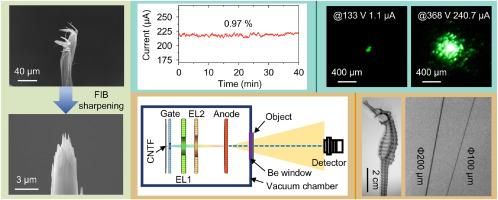A micro-focal spot X-ray source using carbon nanotube fiber cold cathode to achieve high resolution imaging
IF 11.6
2区 材料科学
Q1 CHEMISTRY, PHYSICAL
引用次数: 0
Abstract
Facing the precising X-ray imaging applications such as medical and integrated circuit industry, high resolution micro-focal spot X-ray source is in urgent need. In this work, a novel carbon nanotube fiber (CNTF) was introduced as the microscale cold cathode for the X-ray source. The precising fabrication and field emission characteristics of CNTF cathode were carried out. The apex of the CNTF exhibited a cone-like structure with a diameter of 3.2 μm, which gives an extremely high current density of 3632.6 A/cm2, high reduced brightness of 1.14 × 1010 A m−2·sr−1·V−1, low semi-angle of divergence of 11.3°, and low current fluctuation of 0.97 %. Benefit from the microscale CNTF cathode, a transmission type micro-focal spot X-ray source was assembled using a simple electrooptical structure. The measured X-ray FSS was 15.6 μm and the imaging resolution of 8.0 lp/mm was achieved at the anode voltage of 45 kV and anode current of 31.8 μA. The results demonstrated that the CNTF cold cathode based micro-focal spot X-ray source is a convenient and low-cost device solution which have a great potential in the applications of microscale object and biological tissue imaging.

一种利用碳纳米管光纤冷阴极实现高分辨率成像的微焦点x射线源
面对医疗、集成电路等精密x射线成像应用,迫切需要高分辨率的微焦点x射线源。本文介绍了一种新型碳纳米管纤维(CNTF)作为x射线源的微尺度冷阴极。研究了CNTF阴极的精密制作和场发射特性。CNTF尖端呈直径3.2 μm的圆锥形结构,具有3632.6 a /cm2的极高电流密度、1.14 × 1010 am−2·sr−1·V−1的高亮度、11.3°的低发散角和0.97%的低电流波动。利用微尺度CNTF阴极,利用简单的光电结构组装了透射型微焦斑x射线源。在阳极电压为45 kV,阳极电流为31.8 μA的条件下,测得的x射线FSS尺寸为15.6 μm,成像分辨率为8.0 lp/mm。结果表明,基于CNTF冷阴极的微焦点x射线源是一种方便、低成本的器件解决方案,在微尺度物体和生物组织成像方面具有很大的应用潜力。
本文章由计算机程序翻译,如有差异,请以英文原文为准。
求助全文
约1分钟内获得全文
求助全文
来源期刊

Carbon
工程技术-材料科学:综合
CiteScore
20.80
自引率
7.30%
发文量
0
审稿时长
23 days
期刊介绍:
The journal Carbon is an international multidisciplinary forum for communicating scientific advances in the field of carbon materials. It reports new findings related to the formation, structure, properties, behaviors, and technological applications of carbons. Carbons are a broad class of ordered or disordered solid phases composed primarily of elemental carbon, including but not limited to carbon black, carbon fibers and filaments, carbon nanotubes, diamond and diamond-like carbon, fullerenes, glassy carbon, graphite, graphene, graphene-oxide, porous carbons, pyrolytic carbon, and other sp2 and non-sp2 hybridized carbon systems. Carbon is the companion title to the open access journal Carbon Trends. Relevant application areas for carbon materials include biology and medicine, catalysis, electronic, optoelectronic, spintronic, high-frequency, and photonic devices, energy storage and conversion systems, environmental applications and water treatment, smart materials and systems, and structural and thermal applications.
 求助内容:
求助内容: 应助结果提醒方式:
应助结果提醒方式:


